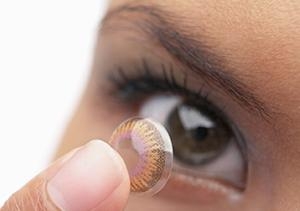Overnight lenses restore up-close vision
Wearing overnight specially designed rigid contact lenses that reshape the eye could remove the need for reading glasses in middle age, a UNSW study shows.
Wearing overnight specially designed rigid contact lenses that reshape the eye could remove the need for reading glasses in middle age, a UNSW study shows.

Wearing specially designed rigid contact lenses overnight that reshape the eye could remove the need for reading glasses in middle age, a UNSW study shows.
Dr Paul Gifford and Professor Helen Swarbrick, of the School of Optometry and Vision Science, tested the technique, known as hyperopic orthokeratology, on 16 patients aged between 43 and 59 years who had age-related loss of near vision, or presbyopia.
Their study is published in Optometry and Vision Science, the official journal of the American Academy of Optometry.
“Our study shows that hyperopic orthokeratology lenses can correct presbyopia,” Professor Swarbrick said.
“Use of the lenses would bring the advantage of visual correction during waking hours, without the need for glasses and contact lenses, to a rapidly growing sector of the population.”
Presbyopia is caused by loss of flexibility in the ocular lens inside the eye that focuses light on the back of the eye. By about age 45 to 50, most people need bifocals or some form of vision correction to restore vision for reading and other up-close tasks.
Orthokeratology, or OK, lenses manipulate the shape of the cornea – the transparent front part of the eye that lets light in.
Dr Gifford and Professor Swarbrick tested a monocular technique, in which the patients wore a custom-made OK lens on one eye overnight for a week. To preserve normal vision in the distance the other eye was left untreated.
“In all patients the monocular technique was successful in restoring up-close vision in the treated eye. The improvement was apparent on the first day after overnight wear, and increased during the treatment week,” Professor Swarbrick said.
“Eye examination confirmed that the OK lenses altered the shape of the cornea, as they had been designed to do.”
To retain the correction in near vision, patients had to continue wearing their OK lenses every night. As expected, when patients stopped using the lenses after the treatment week, their presbyopia rapidly returned.
“All patients retained normal distance vision in the untreated eye,” Professor Swarbrick said.
Three patients in the study stopped wearing the lenses after the first night due to discomfort.
The researchers also noted that longer studies on larger numbers of people were currently in progress to confirm the results and to show that the effects on the eye were reversible after longer periods of use of the lenses.
Wearing OK lenses overnight is not a new technique, but has been mainly used to reduce near sightedness in younger patients.
Alternative treatments for presbyopia, apart from wearing glasses, include fitting a contact lens for distance vision in one eye during the day and a lens for near vision in the other eye, or fitting multifocal contact lenses for daytime lens wear.
Dr Anthony Adams, Editor- in-Chief of Optometry and Vision Science, which is published by Wolters Kluwer Health, likened the OK lens technique to orthodontic treatment, where a retainer is worn in the mouth overnight to keep teeth in alignment.
This OK lens technique “will certainly appeal to many people, especially since the changes in the corneal curvature of the treated eye are fully reversible,” Dr Adams said.
Contacts: Professor Helen Swarbrick: 9385 4373, 0427 992 048, h.swarbrick@unsw.edu.au Dr Paul Gifford: 0423 489 596, p.gifford@unsw.edu.au UNSW Science media liaison; Deborah Smith, 9385 7307; 0478 492 060, deborah.smith@unsw.edu.au